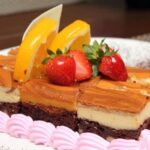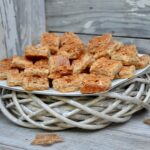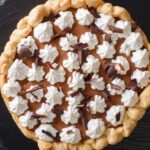Are you wondering how to stick icing decorations to a cake for a visually appealing and professional finish? Whether you’re a beginner or an experienced baker, mastering the art of properly adhering icing decorations is essential for achieving a flawless cake presentation. In this article, we will explore the different types of icing decorations and provide step-by-step guidance on how to stick them to your cakes with ease.
Icing decorations come in various forms, including fondant, royal icing, buttercream, and edible sugar decorations. Each type requires specific techniques and methods for proper adhesion to the cake’s surface. We’ll discuss the importance of preparing the cake surface, using edible glue as a safe and effective sticking agent, and provide tips for troubleshooting common issues when applying icing decorations.
Whether you’re looking to embellish your cake with intricate fondant designs, delicate royal icing piping, or smooth buttercream accents, we’ve got you covered. By following our comprehensive guide, you’ll be equipped with the knowledge and skills needed to elevate your cake decorating game and achieve professional-looking results every time. So let’s dive in and discover the secrets to successfully sticking icing decorations to your cakes.
Types of Icing Decorations
When it comes to decorating a cake, there are various types of icing decorations to choose from. Each type offers unique qualities and techniques for sticking them to a cake. Fondant, royal icing, buttercream, and edible sugar decorations are popular choices for adding flair and creative design to cakes. It is crucial to understand the characteristics of each type of icing decoration in order to properly adhere them to a cake for a visually appealing finish.
Fondant is a pliable sugar paste that can be rolled out into sheets and draped over a cake for a smooth finish. It can also be shaped and molded into intricate designs such as flowers, ribbons, or figures. Royal icing, on the other hand, is made from powdered sugar and egg whites, resulting in a hard, glossy texture when set.
This makes it ideal for creating delicate piped designs and intricate details that can be placed directly onto the surface of the cake. Buttercream is a creamy and spreadable frosting that can be used not only as a delicious topping but also as an adhesive for attaching icing decorations to a cake.
To successfully stick icing decorations to a cake, it’s important to prepare the surface properly by ensuring it’s clean, dry, and free from any crumbs or grease. Using edible glue is one safe and effective method for adhering fondant or gum paste decorations to the cake.
Edible glue can be easily made at home using ingredients such as water, tylose powder (a food grade adhesive), or clear piping gel. This versatile adhesive allows for precise placement of decorations without leaving any residue or affecting the taste of the cake.
| Type of Icing Decoration | Characteristics |
|---|---|
| Fondant | Pliable sugar paste that can be shaped into intricate designs. |
| Royal Icing | Made from powdered sugar and egg whites, resulting in hard glossy texture when set. |
| Buttercream | Creamy and spreadable frosting that serves as both topping and adhesive. |
Preparing the Surface
When it comes to decorating a cake with icing decorations, one of the most important steps is preparing the surface of the cake. This is crucial for ensuring that the decorations adhere properly and result in a professional finish. The preparation process involves making sure that the cake surface is clean, dry, and free from any crumbs or grease that could hinder the sticking process.
To begin, it’s essential to allow the cake to cool completely before attempting to apply any icing decorations. A warm or hot cake can cause icing decorations to melt or slide off, so patience is key in this step. Once the cake has cooled, it’s important to remove any loose crumbs from the surface by gently brushing them away with a pastry brush or clean, dry paper towel.
In addition to removing crumbs, it’s crucial to ensure that the cake surface is free from any grease or moisture. Grease can prevent icing decorations from sticking properly, and moisture can cause them to dissolve or become soggy. To address this, consider chilling your cake in the refrigerator for a short period before applying icing decorations.
It’s worth noting that different types of icings and frostings may require specific preparation methods for ensuring a clean and suitable surface for decorations. For example, buttercream should be allowed to set before applying fondant decorations on top of it.
On the other hand, royal icing should be used on smooth and dry surfaces for optimal adherence. By taking these factors into account and following proper preparation techniques, you can ensure that your icing decorations will stick securely to your cake.
| Preparation Step | Description |
|---|---|
| Allow Cake To Cool | Ensuring that the cake has cooled completely before starting on decoration |
| Remove Loose Crumbs | Gently brushing away any loose crumbs from the cake surface using a pastry brush or clean dry paper towel. |
| Absence Of Grease/Moisture | Making sure no greasy spots are present and removing any condensation/moisture from frosting. |
Using Edible Glue
Understanding the Importance of Edible Glue
When it comes to cake decorating, the right adhesive is crucial for ensuring that icing decorations stay put and create a visually stunning finish. Edible glue is a safe and effective method for sticking icing decorations to a cake, as it is specially formulated for use with food items. Unlike regular craft glue, edible glue is non-toxic and specifically designed for use on edible items.
Making Your Own Edible Glue
If you prefer to make your own edible glue at home, there are simple recipes that only require a few common ingredients. One popular recipe involves mixing tylose powder or gum tragacanth with water until it reaches a thick, paste-like consistency. This homemade edible glue can be used to adhere fondant, royal icing, or sugar decorations to your cake with ease. Alternatively, you can also use simple syrup or apricot glaze as edible adhesive options.
Tips for Using Commercial Edible Glue
For those who prefer the convenience of commercial products, there are various types of edible glue available in stores that are specifically designed for cake decorating purposes. When using commercial edible glue, it’s important to follow the manufacturer’s instructions and apply it sparingly to avoid excessive moisture on the cake surface. Additionally, allow the glued decorations to set in place before handling the cake further.
Applying Fondant Decorations
When it comes to decorating a cake, fondant is a popular choice for creating intricate and detailed designs. Whether you’re adding flowers, ribbons, or figurines, fondant decorations can take your cake to the next level. Here’s a step-by-step guide on how to apply fondant decorations to a cake, including tips for smoothing and shaping the fondant:
1. Prepare the surface: Before applying fondant decorations to your cake, it’s essential to ensure that the surface is clean, dry, and free from any crumbs or grease. This will provide a smooth and stable base for your fondant decorations.
2. Roll out the fondant: Start by rolling out the fondant on a clean work surface dusted with powdered sugar to prevent sticking. Use a rolling pin to create an even layer of fondant that is slightly larger than the area you plan to cover on the cake.
3. Apply the fondant: Carefully lift the rolled-out fondant using a rolling pin or your hands and drape it over the cake. Gently smooth the top of the fondant with your hands, working from the center towards the edges to eliminate any air bubbles or wrinkles.
4. Shape and smooth: Once the fondant is in place, you can use smoothing tools, such as a fondant smoother or paddle, to gently shape and smooth the edges of the fondant against the sides of the cake for a seamless finish.
5. Add additional decorations: If you are adding more intricate design elements made from fondant, such as flowers or figurines, use edible glue to secure them in place on the cake. You can also paint details with food coloring or edible luster dust for added dimension.
By following these steps and techniques for applying fondant decorations to a cake, you can create stunning designs that will impress your friends and family at any special occasion.
Using Royal Icing
Royal icing is a versatile and popular choice for adhering icing decorations to a cake, especially when creating intricate designs. It is made from egg whites or meringue powder, powdered sugar, and flavorings. Here are the steps to successfully use royal icing to decorate your cake:
1. Prepare the royal icing: The first step is to prepare the royal icing by mixing together the egg whites or meringue powder with powdered sugar until it reaches a thick, smooth consistency. You can also add flavorings or food coloring at this stage to customize the color and taste of the icing.
2. Piping method: To use royal icing for piping intricate designs onto your cake, fill a pastry bag fitted with a small round tip with the prepared royal icing. Use gentle pressure to pipe the design onto the cake surface, ensuring that the lines are smooth and even. Allow the piped design to dry and set before adding any additional decorations or layers.
3. Flooding method: The flooding technique involves using thinned royal icing to create a smooth and even layer of icing on top of a cookie or cake surface before piping other intricate designs on top. To flood an area with royal icing, outline the desired shape with a thicker consistency of royal icing and then fill in the shape using thinner royal icing.
By following these steps and methods for using royal icing as an adhesive for your cake decorations, you can achieve professional-looking results that will impress your guests. With practice and patience, you can master this technique and create stunning edible works of art on your cakes.
Buttercream Sticking Methods
One popular method for sticking icing decorations to a cake is using buttercream as the adhesive. Buttercream is not only delicious but also a versatile medium for securing edible decorations. There are several techniques that can be used to ensure that your icing decorations stay in place and create a stunning finish on your cake.
The Glue and Press Technique
One effective technique for sticking icing decorations with buttercream is the glue and press method. To use this method, start by applying a small amount of buttercream to the back of your decoration using a small offset spatula or piping bag. Then, gently press the decoration onto the desired area of the cake. The buttercream acts as an adhesive, holding the decoration in place while providing a tasty addition to each bite.
Adding Stability With Stiff Buttercream
To further enhance the sticking power of buttercream, you can also make stiff buttercream by adding more powdered sugar to create a thicker consistency. This stiff buttercream can act as a more solid base for heavier or larger icing decorations, ensuring that they stay in place without sliding off the cake.
Using Piping Techniques
Another effective way to stick icing decorations with buttercream is by using piping techniques. By piping an outline or base layer of buttercream onto the cake before placing the decorations, you are creating a secure foundation for them to adhere to. You can also use piping bags and tips to apply detailed designs or patterns with buttercream, which not only serves as an adhesive but also adds decorative elements to your cake.
By using these tips and tricks for sticking icing decorations with buttercream, you can ensure that your cakes have professionally finished look while adding delicious flavor at the same time. Experiment with different methods and find what works best for your specific decorating needs.
Troubleshooting
When it comes to decorating a cake with icing decorations, one common challenge that many bakers face is ensuring that the decorations stay put and don’t slide off. This can be frustrating, especially after putting in so much time and effort into creating beautiful and intricate designs. However, there are several common issues that can arise when sticking icing decorations to a cake, as well as solutions to address them.
One common issue when sticking icing decorations to a cake is not preparing the surface properly. If the cake surface is not clean, dry, or free from crumbs or grease, the icing decorations may have trouble adhering to the cake.
To address this issue, it’s essential to ensure that the cake is properly prepped before attempting to stick any decorations. Take the time to carefully clean and dry the surface of the cake, and consider using a light layer of frosting or buttercream as a base for the decorations to stick to.
Another issue that may arise when sticking icing decorations to a cake is using the wrong type of adhesive. Depending on the type of decoration and the texture of the cake, certain adhesives such as edible glue, royal icing, or buttercream may work better than others. If you find that your decorations are not staying put, consider experimenting with different adhesives to find one that works best for your specific situation.
In addition to preparation and adhesive issues, environmental factors such as temperature and humidity can also play a role in causing icing decorations to slide off a cake. If you’re working in a particularly warm or humid environment, consider chilling your decorations in the refrigerator for a few minutes before placing them on the cake.
This can help firm up the icing and make it easier for them to adhere to the cake’s surface. By addressing these common issues and finding suitable solutions, you can ensure that your icing decorations stick securely to your cakes for a visually appealing finish.
Conclusion
In conclusion, properly sticking icing decorations to a cake is essential for achieving a visually appealing and professional finish. Throughout this article, we have explored the different types of icing decorations such as fondant, royal icing, buttercream, and edible sugar decorations. We have also discussed the importance of preparing the cake surface by ensuring it’s clean, dry, and free from any crumbs or grease.
One effective method for sticking icing decorations to a cake is using edible glue, which is safe and easy to make at home. Additionally, we have provided step-by-step guides and tips for applying fondant decorations, using royal icing, and utilizing buttercream as a sticking agent for icing decorations. Furthermore, we addressed common issues and challenges when sticking icing decorations to a cake along with solutions.
It’s crucial to emphasize the significance of proper technique and preparation for successfully sticking icing decorations to a cake. By following the guidelines outlined in this article, readers can enhance their decorating skills and achieve professional-looking results.
For those interested in exploring more advanced decorating techniques, there are additional resources available to further expand their knowledge and creativity in cake decoration. With these tools at their disposal, readers can confidently create stunning cakes adorned with beautifully adhered icing decorations.
Frequently Asked Questions
How Do You Stick Cake Decorations to a Cake?
Cake decorations can be easily stuck to a cake using a small amount of frosting or icing as “glue.” Simply apply a dab of frosting to the back of the decoration and press it onto the cake gently.
How Do You Get Ready Made Icing to Stick to a Cake?
Ready-made icing can be made to stick to a cake by lightly dampening the surface of the cake with a mist of water or by brushing it with simple syrup. This helps the icing adhere to the cake more effectively.
How Do You Stick Icing Flowers to a Cake?
To stick icing flowers to a cake, use a tiny bit of fresh royal icing on the back of each flower and press it gently onto the cake. Royal icing acts as an edible adhesive for attaching decorations securely to the cake surface.

Welcome to my blog about home and family. This blog is a place where I will share my thoughts, ideas, and experiences related to these important topics. I am a stay-at-home mom with two young children. I hope you enjoy reading it! and may find some helpful tips and ideas that will make your home and family life even better!





